House modifications for preventing malaria
- PMID: 33471371
- PMCID: PMC8642787
- DOI: 10.1002/14651858.CD013398.pub3
House modifications for preventing malaria
Update in
-
House modifications for preventing malaria.Cochrane Database Syst Rev. 2022 Oct 6;10(10):CD013398. doi: 10.1002/14651858.CD013398.pub4. Cochrane Database Syst Rev. 2022. PMID: 36200610 Free PMC article.
Abstract
Background: Despite being preventable, malaria remains an important public health problem. The World Health Organization (WHO) reports that overall progress in malaria control has plateaued for the first time since the turn of the century. Researchers and policymakers are therefore exploring alternative and supplementary malaria vector control tools. Research in 1900 indicated that modification of houses may be effective in reducing malaria: this is now being revisited, with new research now examining blocking house mosquito entry points or modifying house construction materials to reduce exposure of inhabitants to infectious bites.
Objectives: To assess the effects of house modifications on malaria disease and transmission.
Search methods: We searched the Cochrane Infectious Diseases Group Specialized Register; Central Register of Controlled Trials (CENTRAL), published in the Cochrane Library; MEDLINE (PubMed); Embase (OVID); Centre for Agriculture and Bioscience International (CAB) Abstracts (Web of Science); and the Latin American and Caribbean Health Science Information database (LILACS), up to 1 November 2019. We also searched the WHO International Clinical Trials Registry Platform (www.who.int/ictrp/search/en/), ClinicalTrials.gov (www.clinicaltrials.gov), and the ISRCTN registry (www.isrctn.com/) to identify ongoing trials up to the same date.
Selection criteria: Randomized controlled trials, including cluster-randomized controlled trials (cRCTs), cross-over studies, and stepped-wedge designs were eligible, as were quasi-experimental trials, including controlled before-and-after studies, controlled interrupted time series, and non-randomized cross-over studies. We only considered studies reporting epidemiological outcomes (malaria case incidence, malaria infection incidence or parasite prevalence). We also summarised qualitative studies conducted alongside included studies.
Data collection and analysis: Two review authors selected eligible studies, extracted data, and assessed the risk of bias. We used risk ratios (RR) to compare the effect of the intervention with the control for dichotomous data. For continuous data, we presented the mean difference; and for count and rate data, we used rate ratios. We presented all results with 95% confidence intervals (CIs). We assessed the certainty of evidence using the GRADE approach.
Main results: Six cRCTs met our inclusion criteria, all conducted in sub-Saharan Africa; three randomized by household, two by village, and one at the community level. All trials assessed screening of windows, doors, eaves, ceilings or any combination of these; this was either alone, or in combination with eave closure, roof modification or eave tube installation (a "lure and kill" device that reduces mosquito entry whilst maintaining some airflow). In two trials, the interventions were insecticide-based. In five trials, the researchers implemented the interventions. The community implemented the interventions in the sixth trial. At the time of writing the review, two of the six trials had published results, both of which compared screened houses (without insecticide) to unscreened houses. One trial in Ethiopia assessed screening of windows and doors. Another trial in the Gambia assessed full screening (screening of eaves, doors and windows), as well as screening of ceilings only. Screening may reduce clinical malaria incidence caused by Plasmodium falciparum (rate ratio 0.38, 95% CI 0.18 to 0.82; 1 trial, 184 participants, 219.3 person-years; low-certainty evidence; Ethiopian study). For malaria parasite prevalence, the point estimate, derived from The Gambia study, was smaller (RR 0.84, 95% CI 0.60 to 1.17; 713 participants, 1 trial; low-certainty evidence), and showed an effect on anaemia (RR 0.61, 95% CI 0.42, 0.89; 705 participants; 1 trial, moderate-certainty evidence). Screening may reduce the entomological inoculation rate (EIR): both trials showed lower estimates in the intervention arm. In the Gambian trial, there was a mean difference in EIR between the control houses and treatment houses ranging from 0.45 to 1.50 (CIs ranged from -0.46 to 2.41; low-certainty evidence), depending on the study year and treatment arm. The Ethiopian trial reported a mean difference in EIR of 4.57, favouring screening (95% CI 3.81 to 5.33; low-certainty evidence). Pooled analysis of the trials showed that individuals living in fully screened houses were slightly less likely to sleep under a bed net (RR 0.84, 95% CI 0.65 to 1.09; 2 trials, 203 participants). In one trial, bed net usage was also lower in individuals living in houses with screened ceilings (RR 0.69, 95% CI 0.50 to 0.95; 1 trial, 135 participants).
Authors' conclusions: Based on the two trials published to date, there is some evidence that screening may reduce malaria transmission and malaria infection in people living in the house. The four trials awaiting publication are likely to enrich the current evidence base, and we will add these to this review when they become available.
Copyright © 2021 The Authors. Cochrane Database of Systematic Reviews published by John Wiley & Sons, Ltd. on behalf of The Cochrane Collaboration.
Conflict of interest statement
JFA has no known conflicts of interest to declare. EAO has no known conflicts of interest to declare. MN has no known conflicts of interest to declare. PG is the Director of the Research, Evidence and Development Initiative (READ‐It) project (project number 300342‐104) and CIDG Co‐ordinating Editor.
Figures
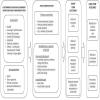
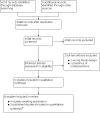


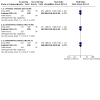
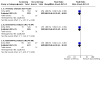
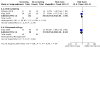


Update of
-
House modifications for preventing malaria.Cochrane Database Syst Rev. 2020 Oct 15;10:CD013398. doi: 10.1002/14651858.CD013398.pub2. Cochrane Database Syst Rev. 2020. Update in: Cochrane Database Syst Rev. 2021 Jan 20;1:CD013398. doi: 10.1002/14651858.CD013398.pub3. PMID: 33058136 Updated.
References
References to studies included in this review
Getawen 2018 {published data only}
-
- Getawen SK, Ashine T, Massebo F, Woldeyes D, Lindtjørn B. Exploring the impact of house screening intervention on entomological indices and incidence of malaria in Arba Minch town, southwest Ethiopia: a randomized control trial. Acta Tropica 2018;181:84-94. - PubMed
Kirby 2009 {published data only}
McCann 2017 (protocol) {published data only}
-
- McCann RS, den Berg H, Diggle PJ, Vugt M, Terlouw DJ, Phiri KS, et al. Assessment of the effect of larval source management and house improvement on malaria transmission when added to standard malaria control strategies in southern Malawi: study protocol for a cluster-randomised controlled trial. BMC Infectious Diseases 2017;17(1):639. - PMC - PubMed
Minakawa 2016 (completed, unpublished) {published data only (unpublished sought but not used)}
-
- Minakawa N, Kongere JO, Sonye GO, Awuor B, Hu J, Lutiali PA, et al. Conference abstract: Covering house eave gaps and ceilings with Olyset® net reduces risk of Plasmodium falciparum parasite infection among children: a cluster randomized controlled trial. 65th Annual Meeting of the American Society of Tropical Medicine and Hygiene; 2016 Nov 13-17 Atlanta (GA) 2016;95(5 Suppl):322.
Pinder 2016 (protocol) {published data only}
-
- Pinder M, Conteh L, Jeffries D, Jones C, Knudsen J, Kandeh B, et al. The RooPfs study to assess whether improved housing provides additional protection against clinical malaria over current best practice in The Gambia: study protocol for a randomized controlled study and ancillary studies. Trials 2016;17(1):275. - PMC - PubMed
Sternberg 2018 (protocol) {published data only}
-
- Sternberg ED, Cook J, Ahoua Alou LP, Aoura CJ, Assi SB, Doudou DT, et al. Evaluating the impact of screening plus eave tubes on malaria transmission compared to current best practice in central Côte d’Ivoire: a two armed cluster randomized controlled trial. BMC Public Health 2018;18(1):894. - PMC - PubMed
References to studies excluded from this review
Berti 1960 {published data only}
-
- Berti AL, Suarez MA, Cheng Hurtado A. The Division of Malariology, with its studies and its program on a healthful rural dwelling, offers to the agrarian reform the method, the doctrine and the skill for fighting against the thatched hut. Revista Venezolana de Sanidad y Asistencia Social 1960;25:55-60. - PubMed
Gouissi 2013 {published data only}
-
- Gouissi FM, Salifou S, Edorh AP, Sedjame AR, Gouissi SG, Yadouleton WA, et al. Contribution of poses screen preimpregnated (PSP) installed at openings and eaves of dwellings in the reduction of malaria transmission in the commune of Aguégués in Benin. Asian Pacific Journal of Tropical Medicine 2013;6:61-7. - PubMed
Additional references
Andriessen 2015
-
- Andriessen R, Snetselaar J, Suer RA, Osinga AJ, Deschietere J, Lyimo IN, et al. Electrostatic coating enhances bioavailability of insecticides and breaks pyrethroid resistance in mosquitoes. Proceedings of the National Academy of Sciences of the United States of America 2015;112(39):12081-6. - PMC - PubMed
Babalola 2016
Balshem 2011
-
- Balshem H, Helfand M, Schünemann HJ, Oxman AD, Kunz R, Brozek J, et al. GRADE guidelines: 3. Rating the quality of evidence. Journal of Clinical Epidemiology 2011;64(4):401-6. - PubMed
Bhatt 2015
Bousema 2012
Boyd 1926
-
- Boyd MF. The influence of obstacles unconsciously erected against anophelines (housing and screening) upon the incidence of malaria. American Society of Tropical Medicine and Hygiene 1926;s1-6(2):157-60.
Bruce 2000
Celli 1901
-
- Celli A. The new preventative treatment of malaria in Latium. Collected Papers on Malaria 1901;1899-1912:1-12.
Charlwood 2003
Covidence [Computer program]
-
- Veritas Health Innovation Covidence. Melbourne, Australia: Veritas Health Innovation, accessed prior to 24 September 2020. Available at covidence.org.
Eshun‐Wilson 2019
FIRS 2017
-
- Forum of International Respiratory Societies. The Global Impact of Respiratory Disease. Second edition. www.who.int/gard/publications/The_Global_Impact_of_Respiratory_Disease.pdf (accessed 5 August 2019).
Foy 2019
Gachelin 2018
Gillies 1968
-
- Gillies MT, De Meillon B. The Anophelinae of Africa south of the Sahara (Ethiopian Zoogeographical Region). South African Institute for Medical Research, 1968.
Guyatt 2011
-
- Guyatt GH, Oxman AD, Schünemann HJ, Tugwell P, Knottnerus A. GRADE guidelines: a new series of articles in the Journal of Clinical Epidemiology. Journal of Clinical Epidemiology 2011;64(4):380-2. - PubMed
Guyatt 2013
-
- Guyatt G, Oxman AD, Sultan S, Brozak J, Glasziou P, Alonso-Coello P, et al. GRADE guidelines: 11. Making an overall rating of confidence in effect estimates for a single outcome and for all outcomes. Journal of Clinial Epidemiology 2013;66(2):151-7. - PubMed
Harbord 2006
-
- Harbord RM, Egger M, Sterne JA. A modified test for small-study effects in meta analyses of controlled trials with binary endpoints. Statistics in Medicine 2006;25(20):3443-57. - PubMed
Hasyim 2018
Higgins 2011
-
- Higgins JP, Green S, editor(s). Cochrane Handbook for Systematic Reviews of Interventions Version 5.1.0 (updated March 2011). The Cochrane Collaboration, 2011. Available from handbook.cochrane.org.
Huho 2013
Jatta 2018
Jawara 2018
Kaindoa 2018
-
- Kaindoa EW, Finda M, Kiplagat J, Mkandawile G, Nyoni A, Coetzee M, et al. Housing gaps, mosquitoes and public viewpoints: a mixed methods assessment of relationships between house characteristics, malaria vector biting risk and community perspectives in rural Tanzania. Malaria Journal 2018;17:298. - PMC - PubMed
Kampango 2013
Kayedi 2008
-
- Kayedi MH, Lines JD, Haghdoost AA, Vatandoost MH, Rassi Y, Khamisabady K. Evaluation of the effects of repeated hand washing, sunlight, smoke and dirt on the persistence of deltamethrin on insecticide-treated nets. Transactions of the Royal Society of Tropical Medicine and Hygiene 2008;102(8):811-6. - PubMed
Keiser 2005
-
- Keiser J, Singer BH, Utzinger J. Reducing the burden of malaria in different eco-epidemiological settings with environmental management: a systematic review. Lancet Infectious Diseases 2005;5(11):695-708. - PubMed
Killeen 2014
Kirby 2008
Lindsay 1988
-
- Lindsay SW, Snow RW. The trouble with eaves; house entry by vectors of malaria. Transactions of the Royal Society of Tropical Medicine and Hygiene 1988;82(4):645-6. - PubMed
Lindsay 2019
Lwetoijera 2013
Manson 1900
Massebo 2013
Mwesigwa 2015
Njie 2009
-
- Njie M, Dilger E, Lindsay SW, Kirby MJ. Importance of eaves to house entry by anopheline, but not culicine, mosquitoes. Journal of Medical Entomology 2009;46(3):505-10. - PubMed
Ogoma 2010
Peterson 2009
-
- Peterson I, Borrell LN, El-Sadr W, Teklehaimanot A. A temporal-spatial analysis of malaria transmission in Adama, Ethiopia. American Society of Tropical Medicine and Hygiene 2009;81(6):944-9. - PubMed
Ranson 2016
-
- Ranson H, Lissenden N. Insecticide resistance in African anopheles mosquitoes: a worsening situation that needs urgent action to maintain malaria control. Trends in Parasitology 2016;32(3):187-96. - PubMed
Review Manager 2020 [Computer program]
-
- Nordic Cochrane Centre, The Cochrane Collaboration Review Manager 5 (RevMan 5). Version 5.4. Copenhagen: Nordic Cochrane Centre, The Cochrane Collaboration, 2020.
Somi 2007
-
- Somi MF, Butler JR, Vahid F, Njau J, Kachur SP, Abdulla S. Is there evidence for dual causation between malaria and socioeconomic status? Findings from rural Tanzania. American Journal of Tropical Medicine and Hygiene 2007;77(6):1020-7. - PubMed
Sternberg 2016
Sterne 2016
Tusting 2015
Tusting 2017
von Seidlein 2017
-
- Seidlein L, Ikonomidis K, Mshamu S, Nkya TE, Mukaka M, Pell C, et al. Affordable house designs to improve health in rural Africa: a field study from northeastern Tanzania. Lancet Planetary Health 2017;1(5):e188-99. - PubMed
WHO 2011
-
- World Health Organization. Vitamin and mineral nutrition information system. Haemoglobin concentrations for the diagnosis of anaemia and assessment of severity. 2011. www.who.int/vmnis/indicators/haemoglobin/en/index.html (accessed prior to 23 January 2019).
WHO 2017a
-
- World Health Organization. World Malaria Report. Geneva, Switzerland: World Health Organization, 2017.
WHO 2017b
-
- World Health Organization. Global Vector Control Response 2017-2030. Geneva, Switzerland: World Health Organization, 2017.
WHO 2018
-
- World Health Organization. World Malaria Report. Geneva, Switzerland: World Health Organization, 2018.
References to other published versions of this review
Furnival‐Adams 2019
-
- Furnival-Adams J, Olanga E, Napier M, Garner P. Housing interventions for preventing malaria. Cochrane Database of Systematic Reviews 2019, Issue 8. Art. No: CD013398. [DOI: 10.1002/14651858.CD013398] - DOI
Publication types
MeSH terms
Substances
Grants and funding
LinkOut - more resources
Full Text Sources
Other Literature Sources
Research Materials
Miscellaneous

